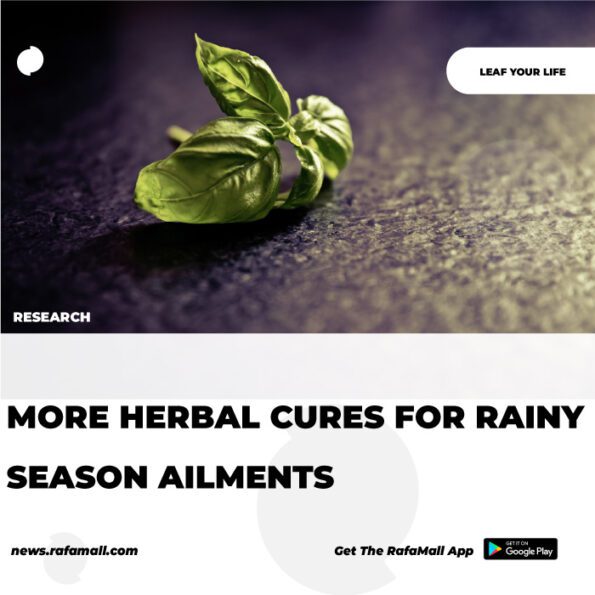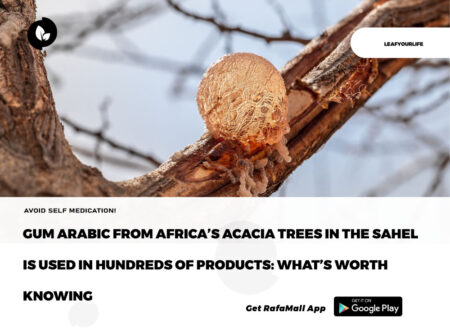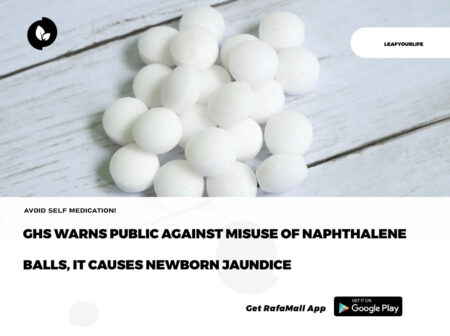By Chukwuma Muanya

The weather has been very cold in recent times. This is not unconnected with heavy rains that have characterised this season. Unfortunately, it is a season that comes with cold, cough, catarrh, sore throat, malaria, typhoid fever and other respiratory diseases like pneumonia and sinusitis as well as water-borne ailments such as diarrhoea and cholera. However, scientists have identified and validated natural remedies for rainy season-related ailments.
Until now, several local herbs have been shown to have antibacterial and antiviral properties. While there are no cures for the flu virus, researchers suggest that many natural remedies can ease the symptom, provide relief and prevent viral infections.
Cold, cough and catarrh
According to the guidance by Public Health England (PHE) and the National Institute of Health and Care Excellence (NICE), acute cough, in most cases are caused by a cold or flu virus, or bronchitis, and will last for around three weeks.
However, Nigerian researchers have demonstrated that local plants can be successfully used to beat the cold virus. The plants include: pepper fruit; African pepper; scent leaf; thyme; onion; garlic; nutmeg; Benin pepper; black pepper; wild pepper; curry leaf; chilli pepper; red pepper; grains of paradise; and ginger.
A study by Ndukwu B.C and Ben-Nwadibia N.B of the Department of Plant Science and Biotechnology, University of Port Harcourt titled, “Etnomedicinal aspects of plants used as spices and condiments in the Niger Delta area of Nigeria” found 23 local spices to have varying therapeutic applications by the local communities. Their uses in ethno-medicine include acting as stimulants, antiseptic carminatives, expectorants, laxatives, purgatives, anticonvulsant, anthelmintic, and sedatives to the treatment of diarrhoea, malaria, rheumatism, asthma, catarrh and bronchitis.
The study, published in African Journal of Environmental Science and Technology, observed that the indigenous people value the plants more for their ethno-medicinal uses than for spicing foods. For instance, ginger is more valued for its treatment of coughs, asthma, colds and hypertension than as condiment.
Deadly drug-resistant lung infection
A potential new treatment combining natural manuka honey with a widely used drug has been developed by scientists at Aston University to treat a potentially lethal lung infection and greatly reduce side effects of one of the current drugs used for its treatment.
The findings, which are published in the journal Microbiology, show that the scientists in the Mycobacterial Research Group in the College of Health and Life Sciences at Aston University were able to combine manuka honey and the drug amikacin in a lab-based nebulisation formulation to treat the harmful bacterial lung infection Mycobacterium abscessus.
Manuka honey is long known to have wide ranging medicinal properties, but more recently has been identified for its broad-spectrum antimicrobial activity. Now scientists have found that manuka honey has the potential to kill a number of drug resistant bacterial infections such as Mycobacterium abscessus, which usually affects patients with cystic fibrosis (CF) or bronchiectasis.
Bronchiectasis as a long-term condition where the airways of the lungs become widened, leading to a build-up of excess mucus that can make the lungs more vulnerable to infection.
In the study, the researchers used samples of the bacteria Mycobacterium abscessus taken from 16 infected CF patients. They then tested the antibiotic amikacin, combined with manuka honey, to discover what dosage was required to kill the bacteria.
As part of the study, the team used a lab-based lung model and nebuliser — a device that produces a fine spray of liquid often used for inhaling a medicinal drug. By nebulising manuka honey and amikacin together, it was found they could improve bacterial clearance, even when using lower doses of amikacin, which would result in less life-changing side-effects to the patient.
Sore throat
Can a combination of hot lemon drink with honey, bitter kola, onions, garlic, ginger and turmeric provide novel ‘cure’ for sore throat?
It is usually associated with dry and cold conditions. A sore throat is pain, scratchiness or irritation of the throat that often worsens when one swallows. The most common cause of a sore throat (pharyngitis) is a viral infection, such as a cold or the flu. A sore throat caused by a virus resolves on its own.
Strep throat (streptococcal infection), a less common type of sore throat caused by bacteria, requires treatment with antibiotics to prevent complications. Other less common causes of sore throat might require more complex treatment.
Researches have shown that sore throat (pharyngitis) accounts for 80 per cent of cases in children and young adults in developing countries. The causes of pharyngitis may be viral, bacterial or environmental causes but the most common cause is Streptococcus pyogenes. This condition is also known as Strep throat and antibiotics such as penicillin and erythromycin are used to prevent complications by S. pyogenes and to ensure speedy recovery.
Also, Non Steroidal Anti Inflammatory Drugs (NSAIDS), acetaminophen and corticosteroids like dexamethasone may be used to relieve pain and inflammation of the pharynx and swelling of lymph nodes.
While antibiotics are useful in pharyngitis relief, resistance to erythromycin has been reported. On the other hand, penicillin possess side effects such as allergy and hypersensitivity, necessitating a search for alternative plant-based remedies.
Fragrances of essential oils of lavender (Lavandula officinalis) have been used to relieve the condition. A study published in the Journal of Pharmaceutical and Scientific Innovation recommends ginger (Zingiber officinale) for treatment of sore throat even as studies indicate that it possesses numerous biological activities, including antibacterial, analgesic and anti-inflammatory properties.
Ginger has also been used in treatment of gastric ulcers and acts by chelating Helicobactor pylori.
The Ugandan researchers concluded: “The results of this study indicate that ginger is a potential source of a sore throat remedy, which validates its continued traditional use for this purpose in the community. Further fractionation of the extracts could lead to isolation of active constituents that may serve as leads for the development of new pharmaceuticals against streptococcal pharyngitis.”
Another study found that when ginger extract was applied to throat swabs from people with bacterial respiratory tract infections, it helped kill some of the bacteria responsible for the illness.
In one study, researchers used computer modeling to find out if ginger could prevent influenza infection — particularly the H1N1 strain that causes swine flu. The team found that the active ingredient in ginger prevents the virus from infecting human cells.
Natural health practitioners suggest gargling with a mixture of water, salt and turmeric (Curcuma longa) powder.
A review of pharmacological activities of turmeric (Curcuma longa) published in Journal of Traditional Medicine & Clinical Naturopathy indicates that the fresh juice of rhizome is given in bronchitis. In rhinitis and cough boil turmeric (Haridra) in milk and mixed with jiggery given internally. In catarrhal cough, sore throat, and throat infection the decoction of rhizome is used for gargling and also the piece of rhizome is slightly burnt and given for chewing. The chemical constituents of Curcuma longa like tumerones, curcuminoids, curcumin and tetrahydrocurcumin has an anti-asthmatic action.
Honey mixed in tea or taken on its own is a common household remedy for a sore throat. One study found that honey was even more effective at taming nighttime coughs than common cough suppressants. Other research shows that honey is an effective wound healer, which means it may help speed healing for sore throats.
According to the Mayo Clinic, mixing honey and lemon with water for a sore throat is a time-tested remedy. Honey can help to coat the throat, and lemon can help reduce mucus. For best results, boil the water first as if making a cup of tea. Then add the honey and lemon to taste and let the water cool as they dissolve. Drink the mixture when it is still slightly warm to help relax the throat muscles or drink it cold if feeling warm because of a fever. Because this mixture only relieves symptoms temporarily, it may be necessary to repeat it throughout the day.
Garcinia kola has been shown to be effective in soothing fever, sore throat, congestions and symptoms of cold and cough. The anti-bacterial properties of the plant help in relieving from worsening of such general but irksome problems.
Apple cider vinegar (ACV) has many natural antibacterial uses. Numerous studies show its antimicrobial effects in fighting infections. Because of its acidic nature, it can be used to help break down mucus in the throat and stop bacteria from spreading.
Garlic also has natural antibacterial properties. It contains allicin, an organosulpher compound known for its ability to fight off infections.
Studies have shown that taking a garlic supplement on a regular basis can help prevent the common cold virus. Adding fresh garlic to your diet is also a way of gaining its antimicrobial properties. Your grandmother might have told you to suck on a clove of garlic to sooth a sore throat. Because garlic has many healing actions, you might try this, though you may want to brush your teeth afterward to protect your teeth from enzymes and improve your breath.
Often used as a pain reliever, cayenne pepper contains capsaicin, a natural compound known for blocking pain receptors.
Although not scientifically proven, ingesting cayenne mixed with warm water and honey can help with pain relief for sore throats. Remember that an initial burning sensation is common. Cayenne should not be taken if you have open sores in your mouth. Start with just a few drops of hot sauce or a light sprinkle of cayenne, as both can be very hot.
Lemon water is a refreshing beverage that may also reduce the throat pain that occurs during a cold or the flu. Lemon contains vitamin C and antioxidants. It also increases the amount of saliva produced, which can help keep the mucous membranes moist.
Combining lemon with warm water and a bit of honey or salt water may be the best way to maximise its benefits. Coconut oil is a versatile food with several health benefits. Animal studies suggest that it may help fight infection, reduce inflammation and relieve pain.
Coconut oil is also very soothing because it helps lubricate the mucous membranes in the throat. Chicken soup is a well-known natural cold and sore throat remedy. It is also a comfort food that allows you to get more fluids when you are sick. You may want to use garlic in it, because garlic contains bioactive compounds that can also provide benefits when you are sick.
Typhoid fever
Several studies have identified plants that could be effectively used singly or in combination to treat multi-drug-resistant (MDR) strains of typhoid fever (caused by Salmonella typhi).
Top on the list are Azadirachta indica (neem tree), Ocimum gratissimum (scent leaf), Carica papaya (pawpaw) and Morinda lucida. Morinda lucida belongs to the plant family Rubiaceae. It is commonly called Brimstone tree. It is Oruwo or Erewo in Yoruba, Eze-ogwu or Njisi in Igbo.
Botanically called Ocimum gratissimum, scent leaf or Basil belongs to the mint family Lameacea. It is called effirin in Yoruba and nchuanwu or arigbe in Igbo. Earlier studies had demonstrated how a herbal preparation made predominantly with garlic, ginger, onions, scent leaf, lemon grass, unripe pawpaw, lime/lemon, African pepper (Uda in Igbo), clove, Gongronema latifolium (Utazi in Igbo, Arokeke in Yoruba) and West African Black pepper (Uziza in Igbo) could be effectively used to prevent and treat malaria and typhoid.
Currently, typhoid fever is a major health problem in developing countries with limited success of treatment with antimicrobial agent. The previous study evaluated the anti Salmonella typhi activity of ethanol, hot and cold crude water extracts of Vitex doniana (root), Cassia tora (leaf), Alstonia boonei (bark), Stachytarpheta jamaicensis (leaf), and Carica papaya (leaf) used as traditional medicine in Ebonyi state, Nigeria. The neem seeds extract and glycyrrhiza extract show comparable same result as compare to ampicillin. The plant extract as naturally synthesise mostl preferably because of having no destructive effects. The frequent use of antimicrobial agent is restricted because the frequent use may cause resistivity, Gastrointestinal (GI) upset and loss of appetite.
The tested methanol extracts of Glycyrrhiza glabra and Azadirachta indica have profound antimicrobial activity against both gram positive and gram-negative bacteria. The valuable zone of inhibition of both extract is especially against Salmonella typhi. The result clearly shows that the herbal extract of both plants shows the same zone of inhibition as compare to controlled drug ampicilin. The quantitative and qualitative differences in inhibition variation are influenced by the method of extraction and concentration.
The researchers identified among others:
*Formulation A, comprising Cymbogogon citratus (lemon grass) leaves, Carica papaya (pawpaw) leaves, and Zea mays (corn) silk.
*Formulation B, comprising C. papaya roots, Mangifera indica (mango) leaves, Citrus limon (lemon) fruit and C. citratus leaves.
Malaria
Can hot infusion from the boiled green leaves of pawpaw combined with leaves of neem tree, lemon grass, guava, and stem bark of pattern wood drunk as one wine glass full three times daily be the elusive treatment for drug-resistant malaria?
Indeed, several local plants have been validated for treating drug-resistant malaria. The local plants were identified by two recent but separate studies published in International Journal of Pharmaceutical Research and Bio-science and International Journal of Pharmaceutical Science and Drug Research.
The local plants include: Neem tree (Azadirachta indica), Pattern wood (Alstonia boonei); Tropical almond (Terminalia catappa); Pawpaw (Carica papaya); Akuamma plant (Picralima nitida); Pentaclethra macrophylla (African oil bean tree); Phyllanthus niruri (stonebreaker); Euphorbia hirta (asthma herb and eczema drug); Newbouldia laevis (Chieftaincy leaf).
Commonly called stonebreaker, Phyllanthus niruri also known as ‘Chanca piedra’ belongs to the family Euphorbiaceae. Phyllanthus niruri is similar to Phyllanthus amarus, which also belongs to the same family.
Euphorbia hirta belongs to the plant family Euphorbiaceae. It is called asin uloko in Edo, endamyel in Fula-Fulfulde, ba ala in Igbo (Owerri), akun esan in Yoruba.
Euphorbia hirta is also locally known as ogwu ngwo (eczema drug) in some eastern parts of Nigeria is used locally to arrest bleeding in the event of an injury. Leaves of Euphorbia hirta are used in traditional medicine for the treatments of boils, wounds and control of diarrhoea and dysentery.
Azadirachta indica: The name is derived from the Persian word azaddhirakt, which means “noble tree”. It is called oguru akam and obisikeosiso in Igbo, Dogo’nyaro in Hausa and aforo oyinbo in Yoruba.
Method of extraction and preparation of Neem: The tender parts of the branches are cut and the leaves with other parts are washed thoroughly and put inside a pot (metal or clay) after the size must have been reduced with knife. About four litres of water are then added and the content boiled for about 30 minutes. It is then allowed to cool for some time and filtration is done with a muslin cloth. The filtrate which is the drug product is administered orally with a glass cup once three times daily, more water is added to continue extraction if the extracts reduces.
The drug extract can sometimes be used as anti-inflammatory, anti-spasmodic and as insecticidal agents. Other medical situations in which Neem can be used are liver ailments, gastric ulcers, constipation, urinary tract conditions, fever, skin problems etc.
Neem products have been shown to exhibit a wide range of effects that are potentially useful for malaria control and include anti-feedancy, ovicidal activity, insect growth regulation and repellency. These effects are frequently attributed to the azadirachtin contents of the products.
Neem-based products are relatively safe towards non-target biota, with only minimal risk of direct adverse effects on aquatic macro invertebrates resulting from contamination of water bodies with neem-based insecticides. In addition, the products are less likely to induce resistance due to their multiple modes of action on insects.
Research on neem products for the control of arthropods of medical and veterinary importance has been ongoing for some time and various studies have focused on the culicine species Culex tarsalis and Culex quinquefaciatus, besides Aedes aegypti. There have also been studies that assessed the larvicidal potential of neem products on anophelines, notably Anopheles culicifacies, Anopheles arabiensis, Anopheles gambiae and Anopheles stephensi.
According to a study published in the Nigerian Journal of Physiology and Science, recently, a fractionated neem-leaf extract known as IRAB with reported activities against malaria, Human Immuno-deficiency Virus (HIV)/Acquired Immune Deficiency Syndrome (AIDS) and cancer has been developed into a drug and currently marketed in Nigeria as IRACAP.
Commonly called pattern wood and stool wood, Alstonia boonei belongs to the plant family Apocynaceae. It is called ofem in Bembi, bokuk in Bokyi, ukhu in Edo, ebo in Efik, etiap in Ejagham, oguk in Ejagham-Etung, uguwa in Engenni, ano in Igala, egbu in Igbo, okugbo in Isekiri, ukpukuhu in Urhobo, ahùn, ako-ibepo, àwiń, or awùn in Yoruba.
Method of extraction and preparation of Alstonia boonei: The fresh barks and leaves are cut with knife, washed thoroughly and put inside a pot containing about two litres of water. The pot content is allowed to boil for 30 minutes and left to cool for 10 minutes after which the content of the pot is filtered using a muslin cloth. The drug filtrate is taken two glassfuls three times daily in feverish conditions to treat malaria. Alstonia boonei also finds usage in the following ailments hypertension, fever, rheumatism, lactation stimulant, parasites, snakebite, arrow poison etc.
According to The Useful Plants of West Tropical Africa, the bark, and the root, are febrifugal and are said in Nigeria to be very effective in the case of ordinary malaria. It reads: “A bark-decoction is also taken in Ghana for malaria and in Cameroun. The bark of an Alstonia sp. is used in India for malaria and chronic diarrhoea. It is said to be inferior to cinchona bark but leaves no after-effects, e.g. no buzzing in the ears. In decoction it is used in Ivory Coast — Upper Volta to cleanse suppurating sores and exposed fractures; in Nigeria for sores and ulcers; on snakebite in Liberia; and for snakebite and arrow-poison in Cameroons…”
Commonly called Tropical almond or Indian almond. Terminalia catappa is an ornamental tropical tree belonging to the family Combretaceae. It is native to Southeast Asia.
Method of extraction and preparation Terminalia catappa: The leaves of Terminalia catappa contain many hydrolysable tannins, such as punicalagin, punicalin, terflavins, A and B tergallagin, tercatain, chebulagic acid, geraniin, granatin B, and corilagin, but no caffeine. The leaves are combined with other components of the plants and boiled. The contents are allowed inside the pot and glass cups are used to scoop the extract and administered orally once two times daily for malaria therapy. The leaves have many medicinal uses including diaphoretic, anti-indigestion and anti- dysentery.
An infusion of the young leaves or scraped bark is occasionally taken as a portion for treating mouth infections in Tonga and Samoa and is used in the Cook Islands to bathe fractures. Young leaves are used in the Philippines to cure headache and colic. The bark is used as an astringent in dysentery and thrush.
According to Wikipedia, the leaves contain several flavonoids (such as kaempferol or quercetin), several tannins (such as punicalin, punicalagin or tercatin), saponines and phytosterols. Due to this chemical richness, the leaves (and the bark) are used in different herbal medicines for various purposes. For instance in Taiwan, fallen leaves are used as an herb to treat liver diseases. In Suriname, an herbal tea made from the leaves is prescribed against dysentery and diarrhea. The leaves may contain agents for prevention of cancers (although they have no demonstrated anticarcinogenic properties) and antioxidants, as well as anticlastogenic characteristics. Extracts of T. catappa have shown activity against Plasmodium falciparum chloroquine (CQ)-resistant (FcB1) and CQ-sensitive (HB3) strains.
Commonly called pawpaw or papaya, Carica papaya belongs to the plant family Caricaceae. In Nigeria, it is also known by different local names depending on the tribe. For example, it is known as Ibepe in Yoruba, gwanda in Hausa, ojo and okwere in Igbo, and etihi- mbakara in Efik.
The ripe fruit is edible and is usually eaten raw, without the skin or seeds. The unripe green fruit (which is a rich source of vitamin A) can be eaten cooked, usually in curries, salads and stews as used in Thai cuisine.
Different parts of the plant are attributed with different medicinal values. For instance, in African folklore medicine, the hot infusion from the boiled green leaves of papaya combined with leaves of Azadirachta indica, Cymbopogon citratus (lemon grass), Psidium guajava (guava) and stem bark of Alstonia boonei is drunk as one wine glass full three times daily in the treatment of malaria.
Method of extraction and preparation of Carica papaya: The leaves are mixed with guava leaves, lime leaves and lemon grass. They are then put inside a pot and the mixture is boiled though the leaves do not have to soften so much. On noticing the coffee colour of the mixture it is assumed that the extraction is complete and boiling is stop instantly. From the content in the pot two glass cups are taken orally twice daily without filtration of the content to treat malaria. Carica papaya can still be used in the following sickness hypertension, digestive problems, stomach pain, diuretic, malaria, parasites etc.
The extracted product apart from being used in malaria therapy is used to treat amoebicide, antihelmintics and as a carminative in our local villages and towns.
Source: Guardian.ng











